Table of Contents
- Most likely, you have been told about the process of cloning. Cloning is an exact copy of genetics. It could be a clone of a gene cell, or an organism. It can even be a human.
- While cloning humans poses ethical dilemmas that are not legal in most countries, the gene cloning process is ongoing for over 30 to forty years. The cloning of animals happening in recent times.
- Gene cloning, also referred to as molecular cloning, relates to the procedure of isolating DNA sequence that is of interest for the purpose of making several replicas.
- The copies that are identical are called clones. It was 1973 when Stanley Cohen and Herbert Boyer came up with methods to create the recombinant DNA that is a kind of synthetic DNA.
- Recombinant DNA is created through the pairing with two or more DNA DNA strands mixing DNA sequences that would never normally meet.
- That is, chosen DNA (or the DNA of “interest”) is added into the genome of an existing organism like the bacterial plasmid DNA or a different vector.
- The recombinant DNA could then be transferred to another cell, like bacteria, to allow an amplifying process and perhaps the production of the protein that results.
- This process is known as transformation, which refers to the genetic change of a cell that results from the incorporation, uptake and expression of genetic material from outside. The technology of recombinant DNA was created thanks to discovering restriction enzymes.
What is Gene cloning?
“DNA Cloning” is a molecular biology technique that is utilized to create exact copies, or clones, of one particular gene or DN.”
- DNA cloning may be explained as the method of creating duplicate copies that are identical to an individual piece of DNA or genetic material.
- In the common process for cloning DNA it is the gene, or DNA fragment that is targeted is first introduced into a circular piece of DNA, also known as a “plasmid.
- This is accomplished by using restriction enzymes which “cut and then paste” to the DNA. This produces a molecule of DNA that is recombinant.
- Then, the recombinant DNA is in the cells of a bacterium.
- The bacterium that carries the plasmid are identified and then grown up.
- When you reproduce, your cells duplicate the plasmid, and then transfer it to their offspring, creating duplicates of the rDNA, or the recombinant DNA they contain.
- In certain cases it is necessary to have many DNA copies for experiments or to construct new plasmids.
- In other instances the DNA fragment contains a protein that is useful and bacteria are employed to make Detection Recombinant Clones: Based on the many colonies that produced the protein. For example the insulin gene of humans is expressed by E. bacteria in order to produce insulin for diabetics.
History of Gene cloning
- The DNA story started when researchers discovered the chemical composition of DNA, by J. Watson and F Crick in 1953.
- The researchers discovered the molecular structure of DNA. They proposed that DNA is composed of three main components: Phosphate, Sugar and nitrogenous bases.
- DNA is found in nearly every living thing, making it is considered to be a molecule of life for each living thing on Earth.
- Different techniques were developed over time to analyze DNA, but the exact time frame of who first cloned DNA was not clear! The year 1903 was the time that Webber J first time used the term “Clone”. In 1973 the first animal gene was copied in the lab of Morrow as well as Cohen et along with. in the collaboration research conducted by Stanford universities and UCFS.
- A biochemist from Stanford University Berg P was the first person to develop Recombinant DNA in the year 1972. It is important to note that recombinant DNA can be described as synthetically prepared DNA with two distinct sources.
- The eukaryotic DNA of Clawed the frog Xenopus was isolated, and then cloned to E Coli. In 1986 Royerand Pokora and co. first cloned a gene that causes the human chronic granulomatous disorder.
Principle of Gene Cloning
- A DNA fragment with the gene that is to be cloned is introduced into a vector that is suitable to create a recombinant DNA molecule.
- The vector serves as a vehicle for transporting the gene to the host cell, which is usually a bacteria, however other kinds of living cells can also be utilized.
- Within the host cell , the vector expands, creating many identical copies of itself, but also the gene it is carrying.
- If your host cells divide, replicas of the DNA molecule recombinant are transferred to the offspring and vector replication occurs.
- After a lot of cell divisions, a clone, or clone of identical host cells can be created.
- Every cell of the clone has one or more copies of the DNA molecule recombinant; the gene that is carried by the recombinant molecule is called a clone.
Requirements for Gene Cloning
- DNA fragment that contains the genes that are wanted to be copied.
- Ligase enzymes and restriction enzymes .
- Vectors are used to carry, keep and duplicate cloned genes in host cells.
- Host cell is a cell in which the recombinant DNA is able to replicate.
Restriction Enzyme Digestion and Ligation
- The restriction endonucleases or restriction enzymes are prokaryotic proteins that cut and recognize DNA in particular sequences, referred to as restriction sites.
- They are believed to have evolved to serve as an effective defense against DNA from foreign sources like viral DNA. More than 3000 enzymes were discovered.
- Some of the most common restriction enzymes can be seen in this table. The arrows that go up and down show the locations of cleavage.
- The names of restriction enzymes are in reference to the prokaryotic species they were taken from. For instance, those that are isolated from Escherichia coli will begin with Eco. As the table below illustrates, digestion using restriction enzymes can result in blunt or overlapping ends.
- EcoRI creates overlapping “sticky” ends. The enzyme cuts in between G and A the strands. However SmaII’s restriction enzyme cleavage creates a “blunt” end. The enzyme breaks between G and the C the strands.
| Enzyme | Source | Recognition Sequence | Restriction Digest |
|---|---|---|---|
| EcoRI | Escherichia coli | 5’GAATTC3’CTTAAG | 5′—G↓AATTC—3’3′—CTTAA↑G—5′ |
| BamHI | Bacillus amyloliquefaciens | 5’GGATCC3’CCTAGG | 5′—G↓GATCC—3’3′—CCTAG↑G—5′ |
| TaqI | Thermus aquaticus | 5’TCGA3’AGCT | 5′—T↓CGA—3’3′—AGC↑T—5′ |
| HinfI | Haemophilus influenzae | 5’GANTCA3’CTNAGT | 5′—G↓ANTC—3’3′—CTNA↑G—5′ |
| Sau3A | Staphylococcus aureus | 5’GATC3’CTAG | 5′—↓GATC—3’3′—CTAG↑—5′ |
| PvuII | Proteus vulgaris | 5’CAGCTG3’GTCGAC | 5′—CAG↓CTG—3’*3′—GTC↑GAC—5′ |
| SmaI | Serratia marcescens | 5’CCCGGG3’GGGCCC | 5′—CCC↓GGG—3’*3′—GGG↑CCC—5′ |
| HaeIII | Haemophilus aegyptius | 5’GGCC3’CCGG | 5′—GG↓CC—3’*3′—CC↑GG—5′ |
Key: N = C or G or T or A
- = blunt ends
Steps in Gene Cloning
- DNA extraction: The extraction of the DNA sequence from the chosen organism.
- Isolating DNA or gene of interest: separating DNA fragments using either chemical or restriction digest.
- Constructing a vector: The process of creating a vector involves the incorporation of DNA in a vector or vehicle that allows it to be transferred to the recipient.
- Introduction into the host cell: Insertion of recombinant DNA into the host organism by chemical, physical or enzymatic method.
- Selecting transformed cells: Selecting transformed cells using a marker that can be selected antimicrobial resistance genes.
- Isolating cloned genes: Isolation and purification of copies of genes in the hosts.
Procedure of Gene cloning
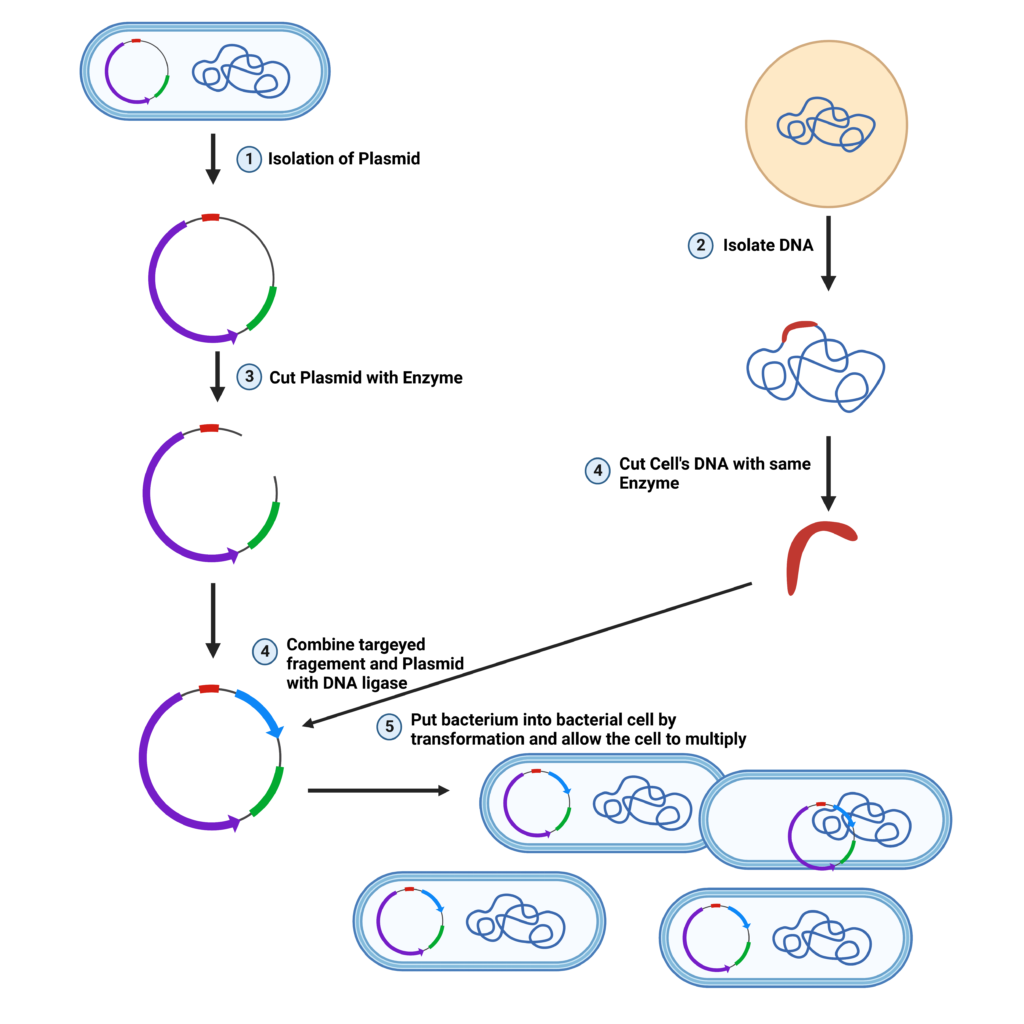
1. Gene Cloning Step 1 – Isolation of DNA (Gene of Interest) Fragments to be Cloned
- The gene or DNA that is targeted needs to be isolated prior to cloning.
- An interest gene is an element of a gene whose product (an enzyme, protein, or hormone) is of interest to us. For instance, the gene that codes the hormone insulin.
- The desired gene could be identified using an endonuclease restriction (RE) enzyme that cut DNA at specific recognition nucleotide sequences referred to as restriction sites to the inside zone (hence endonuclease) making sticky or blunt ends.
- Sometimes reverse transcriptase enzymes can be employed to synthesize complementary DNA strands of the gene desired using its mRNA.
2. Gene Cloning Step 2 – Selection of suitable cloning vector
- Vector is transporter molecules that could transport the gene of interest (GI) into a host, then replicate and also the GI creating multiple copies.
- The cloning vectors can be limited in size to that of the inserts they are able to carry. Based on the size of the insert and application of the insert, the most appropriate vector is chosen.
- The various types of vectors for cloning are bacteriophages, plasmids, bacterial artificial chromosomes (BACs), yeast artificial chromosomes (YACs) and mammalian artificial chromosomes (MACs).
- But, the most commonly utilized cloning vectors are the plasmids as well as bacteriophages (phage l) in addition to the other vectors that are available.
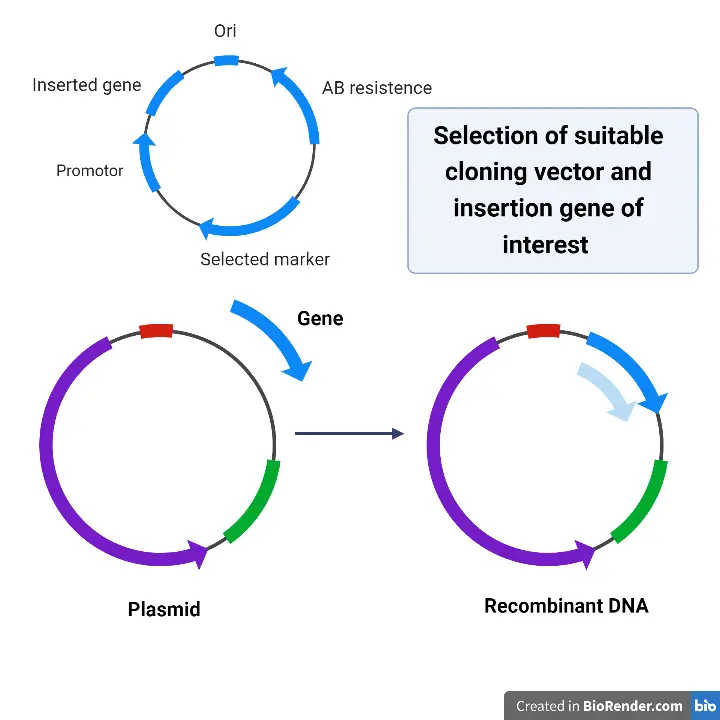
Essential Characteristics of Cloning Vectors
All cloning vectors act as carriers for DNA molecules. The molecules that carry cloning should share a several common features like:
- It has to be self-replicating within the host cell.
- It should have a distinct restricting site to RE enzymes.
- The introduction of donor DNA fragments must not interfere with the reproduction property that the vector has.
- It must have a marker gene that could be used later for detection of recombinant cells (usually an antibiotic-resistant gene that is not present on the cells of the hosts).
- They should be able to be separated from the host cells.
3. Gene Cloning Step 3 – Formation of Recombinant DNA
- The plasmid vector is cut with the RE enzyme that was used to separate the donor DNA fragment.
- The donor DNA fragments and the plasmid vector are mixed.
- With the help of DNA ligase base pairing between donor DNA fragments and plasmid vector is observed
- The DNA molecule that results is a hybrid between two DNA molecules: that of the GI as well as the vector.
- In the field of genetics this intermixing of DNA strands is referred to as recombination.
- This new hybrid DNA molecule can also be called a recombinant DNA mole and is also referred to as the recombinant DNA technique.
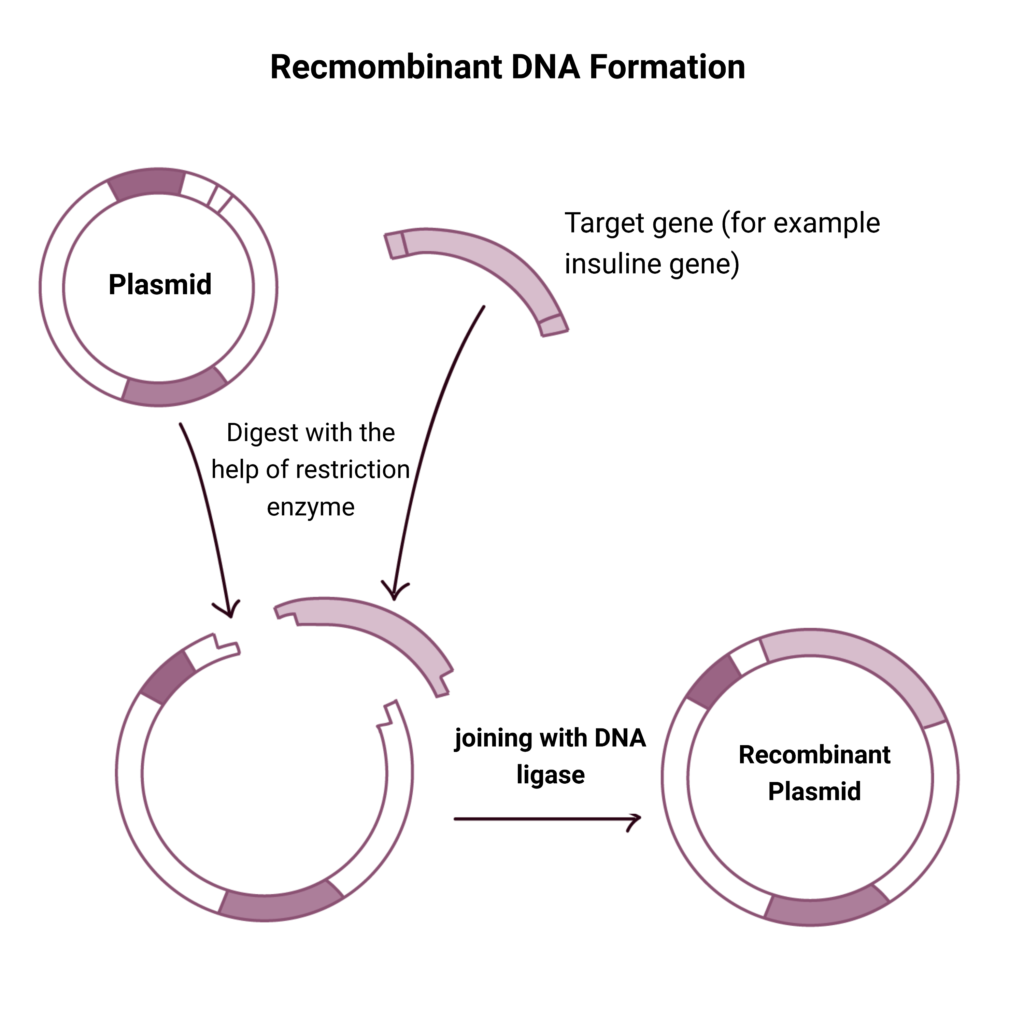
4. Gene Cloning Step 4 – Transformation of recombinant vector into suitable host
- Once our DNA molecule recombinant is complete, we must incorporate it into the living organism known as host.
- It is usually done due to one or both of the following motives:
- In order to duplicate the DNA molecule that is recombinant to create numerous copies that make up our GI.
- In order to let our GI activate and make the protein needed by us.
- Some bacteria can be transformed naturally. They can be transformed into the recombinant gene automatically. Examples include: Bacillus, Haemophillus, Helicobacter Pylori, all of which are all naturally capable.
- Certain other bacteria, however, require incorporation using chemical methods like electroporation, micro-injections, lipofection and so on.
- If we go through this process , some host cells will be able to absorb the recombinant DNA while some won’t. Host cells that have taken in the recombinant DNA will be called transformed cells. This process is referred to as transformation.
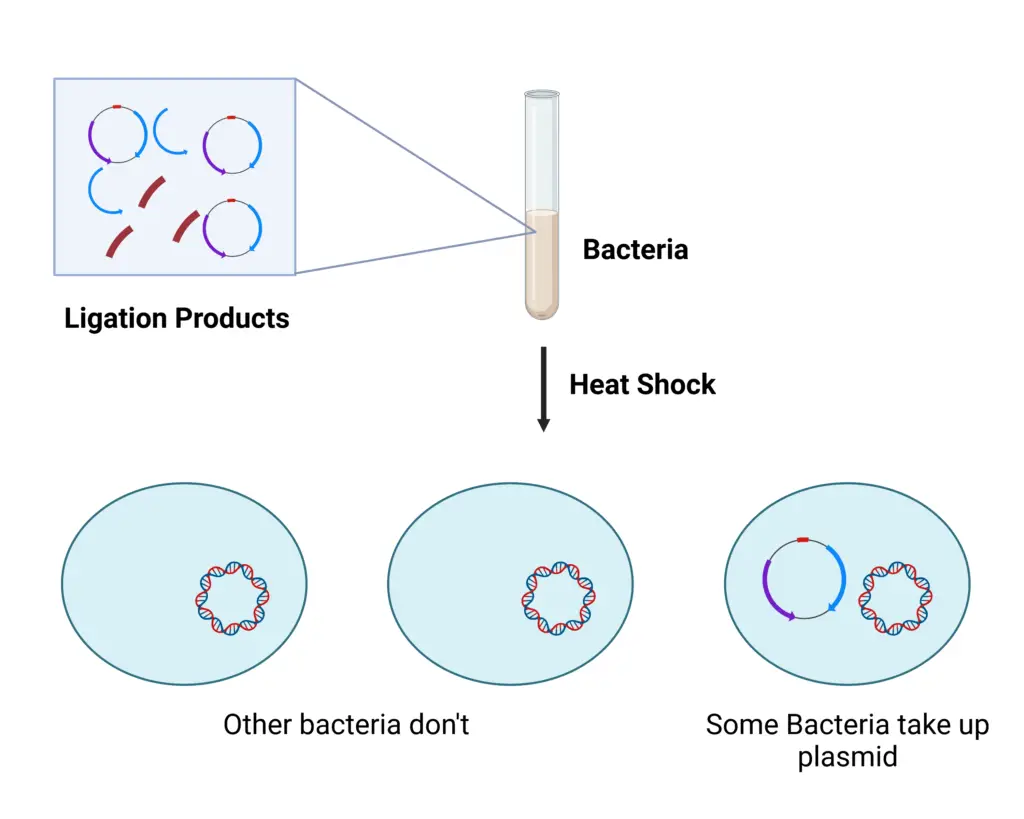
5. Gene Cloning Step 5 – Isolation of Recombinant Cells
- The process of transformation produces a mixed population of transformed and non-trans- formed host cells.
- Since we are only interested in transformed hosts, it is necessary to remove them. This is precisely what is accomplished in the process of selection.
- There are numerous options for selecting a candidate, some of them are based on the use of colony hybridization, reporter genes technique, etc.
- The process involves filtering transformed host cells and only the transformed host cells.
- To separate recombinant cells from non-recombinant cells, the marker gene from the vector plasmid is used.
- For example, PBR322 plasmid vector contains different marker genes (Ampicillin resistant gene and Tetracycline resistant gene. When pst1 RE is employed, it removes the Ampicillin resistance gene on the plasmid in order for the recombinant cells to be more vulnerable to Ampicillin.
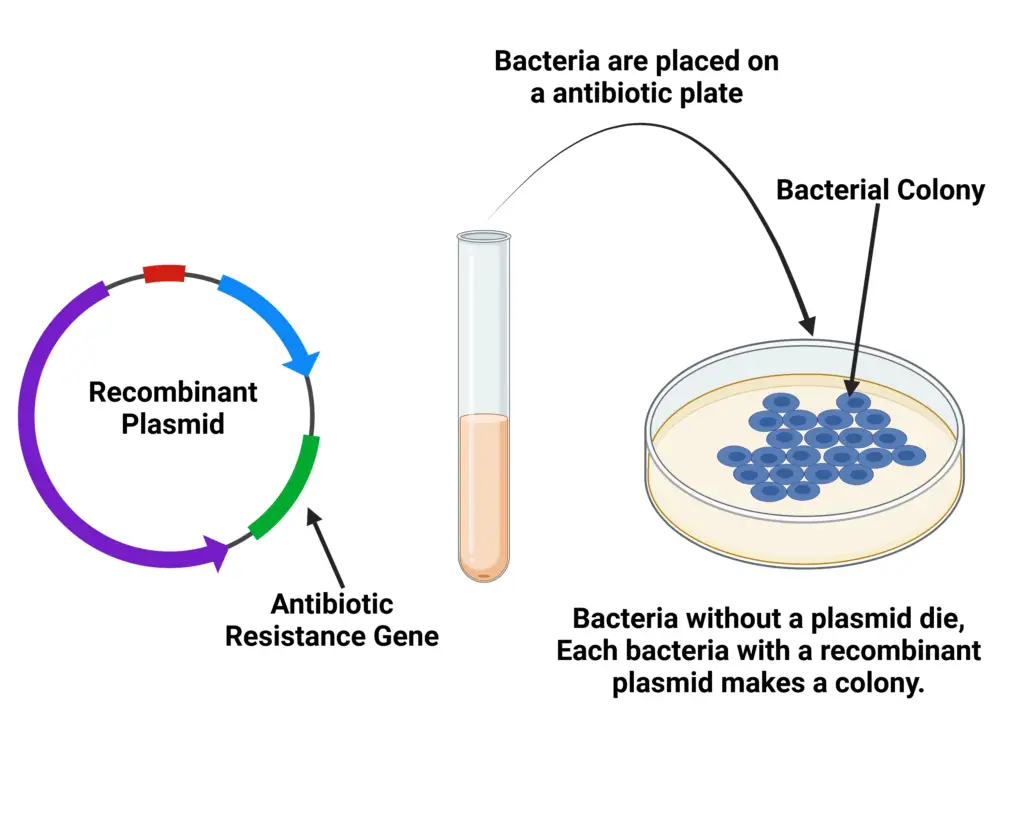
6. Gene Cloning Step 6 – Multiplication/Expression of the Introduced Gene in the Host
- After we have cleansed our host cells that have been transformed by the screening process, it’s now our responsibility to provide them with the right parameters for growth and to multiply.
- The transformative host cells will be then introduced to fresh culture media, which give them a rich diet after which they are incubated inside the oven at appropriate temperature.
- At this point, host cells divide and then re-divide in tandem with their replication process of DNA recombinant carried by them. At this point, we have two options.
- If the goal of cloning is to create the gene library, the goal is to create many duplicates of GI. In this way, with this goal in mind, we’ll just focus on an increase in the number of copies of DNA recombinant and only the initial.
- If the purpose of the cloning study is to create the product of GI then we’ll take one step further by providing favorable conditions for the host cells where the GI in the vector could communicate our product of interest (PI).
7. Gene Cloning Step 7 – Isolation of the Multiplied Gene Copies/Protein Expressed by the Introduced Gene
- In this process, we identify our multiplied GI , which is attached to the vector or protein encoded by it.
- It is a good idea to compare this to the harvesting process when we harvest the crops from the fields. There are many methods of isolation, and the method of selection which differs from case to case.
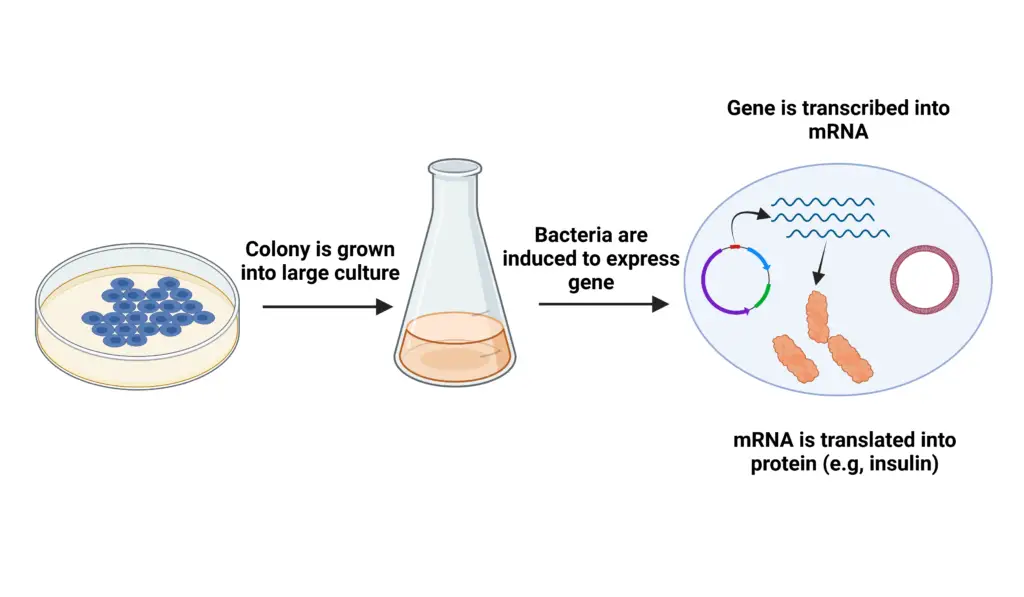
Application of Gene Cloning
There are a variety of uses for gene cloning within the medical and research industries. A few examples are:
- Gene function: This is extensively used in DNA analysis and gene analysis. Simply by cloning genes, either the existence or non-existence of a gene could be established. In addition, by creating the recombinant plasmid purpose of a gene could be established. Gene knockout, knockdown, and transgene creation are other possible applications. But, the conventional method to clone genes to create copies of DNA – is replaced with an effective, quick and economical PCR technique. Utilizing the Taq DNA polymerase PCR can increase or synthesize genes with a rapid time.
- Gene structure: The structure or sequence of a particular gene can be identified by the process of cloning. An important gene can be identified and sequenced to determine the variations in sequence within.
- Construction of genetically modified organisms: The method of gene cloning is extensively used in the creation of genetically modified organisms by using the recombinant DNA method. A transgene , also known as Recombinant DNA, is inserted into plants, bacteria or mice in order to alter characteristics, phenotypes and the role of a particular genetic or disease-related model.
- Gene therapy: One of the intriguing applications of gene cloning used in gene therapy to treat genetic diseases. A damaged DNA sequence or gene can be replaced or repaired by the healthy version.
- Mutational studies and identification of mutations: The technique of gene cloning was employed to determine the presence of mutations as well as other studies on mutagenesis, however it has been substituted with the polymerase chain reactions technique that, as we’ve said, is cost-effective and quick. It is also employed for site-directed mutagenesis research as well.
- Biopharmaceuticals: The production of synthetic or recombinant proteins is among the most innovative applications of gene Cloning. We have already discussed the process. Proteins like insulin and other growth factors were synthesized prior to the method we use today.
Limitations of gene cloning
DNA cloning/gene Cloning or molecular-cloning was one of the most groundbreaking discoveries of the 1980s. However, it does have some drawbacks and limitations.
- The current method is very laborious. It can take 3-4 days to see results. The steps like culturing and restricting digestion can take several days to finish.
- The risk for contamination is even more doubtful.
- The current method is expensive and time-consuming to execute.
- The accuracy and yield of the test are also not sufficient.
FAQ
What is gene cloning?
Gene Cloning is the process of isolating the DNA from a cell and then duplicating it into another organism which is genetically identical to the original. The science behind gene cloning has grown tremendously since the 1990s when scientists were able to isolate human genes, such as insulin, and transfer them into other organisms. Today, scientists are working on transferring genes from one species to another for medical purposes. Scientists also use gene therapy to treat diseases like sickle cell anemia and cystic fibrosis.
What is the purpose of the lacz gene in a plasmid cloning vector?
The lacZ gene encodes beta galactosidase which is responsible for converting X-Gal into a blue color. This enzyme has been used as a reporter of expression from the promoter region of genes cloned in a plasmid. When the plasmids containing the cloned genes are transformed into bacteria, the presence of the plasmid is detected by the activity of the beta galactosidases. If the plasmid contains no insert (no DNA), then no enzyme will be produced and no blue color will appear when cells are stained using X-gal.
What is gene cloning used for?
The process of replicating DNA into another cell is called ‘cloning’. This technology allows researchers to produce identical copies of specific genes from cells of other organisms. One use of this technique is to study how genes influence characteristics like color vision, hair color, height, etc. Another application would be to grow large quantities of genetically modified crops that resist pests.
what is the purpose of an antibiotic resistance gene in a plasmid cloning vector?
The ability to transfer genes from one cell to another and maintain them in new cells is called transformation. Plasmids are used for transferring DNA into bacteria. A common method for doing this is using a bacteriophage, such as lambda phage, which attaches itself to the bacterial cell wall and injects the plasmid into the cell. This process may cause mutations and deletions in the plasmid, which makes it impossible to grow out clones containing the desired mutation. However, the presence of an antibiotic resistance gene allows the transformed cells to survive exposure to antibiotics.
what role do dna ligases have in gene cloning?
Dna ligases play an important role in gene cloning. They help DNA strands bond together during cell division. The process of joining two complementary pieces of DNA together is called ligation.
what is the first step in gene cloning?
The first step in gene cloning is identifying the DNA sequence for the gene you want to clone. This means that you need to find out which genes produce proteins that are important in the body. Once you know the protein, you can go about designing the synthetic version of the gene that produces the protein. Then you have to design the vector that allows the new gene to be copied into the host cell. Finally, you must insert the new gene into the vector, and then infect the bacteria with the vector containing the new gene.
why is pcr often used prior to cloning a gene in cells?
PCR provides a way to amplify DNA templates for analysis. This allows us to copy large amounts of DNA from one sample into another. The process is done through repeated cycles of heating and cooling at specific temperatures.
References
- Zhou Guoling, Yang Guangsheng, Fu Tingdong. Gene cloning techniques Hua Zhong Nong ye da Xue Xue Bao. Journal Huazhong (Central China) Agricultural University. 2001 ;20(6):584-592.
- https://www.vedantu.com/biology/dna-cloning
- https://www.cheric.org/files/education/cyberlecture/e200402/e200402-301.pdf
- https://www.basu.org.in/wp-content/uploads/2020/05/Gene_Cloning.pdf’
- https://www.sciencelearn.org.nz/resources/2031-dna-cloninghttps://opentextbc.ca/biology/chapter/10-1-cloning-and-genetic-engineering/’
- https://www.jove.com/v/5074/molecular-cloning
- https://www.khanacademy.org/science/ap-biology/gene-expression-and-regulation/biotechnology/a/overview-dna-cloning
- https://en.wikipedia.org/wiki/Molecular_cloning
- https://www.biotechnologynotes.com/gene-cloning/7-main-steps-involved-in-gene-cloning/231
- https://passel2.unl.edu/view/lesson/a60bdb7346b1/5
- https://step1.medbullets.com/biochemistry/102099/cloning
- https://www.ck12.org/book/ck-12-biology-advanced-concepts/section/9.2/
- https://geneticeducation.co.in/gene-cloning-definitions-steps-procedure-applications-and-limitations/
- https://www.onlinebiologynotes.com/gene-cloning-steps-involved-gene-cloning/

PCR provides a way to amplify DNA templates for analysis. This allows us to copy large amounts of DNA from one sample into another. The process is done through repeated cycles of heating and cooling at specific temperatures.
The ability to transfer genes from one cell to another and maintain them in new cells is called transformation. Plasmids are used for transferring DNA into bacteria. A common method for doing this is using a bacteriophage, such as lambda phage, which attaches itself to the bacterial cell wall and injects the plasmid into the cell. This process may cause mutations and deletions in the plasmid, which makes it impossible to grow out clones containing the desired mutation. However, the presence of an antibiotic resistance gene allows the transformed cells to survive exposure to antibiotics.